I've been wanting to see a canvasback duck for some time. I've made attempts to find local areas to see them on both eBird and iNaturalist and the sightings have been quite limited. I finally saw a few canvasbacks at a private reservoir in Mentone, quite close to our home, but I couldn't get very close to them and my photos were poor.
Recently, using eBird maps and narrowing down potential places in the Los Angeles area, I discovered that there have been some regular sightings of canvasbacks at the Alondra Park Reservoir near El Camino Community College. I drove down their yesterday and counted eight of them, seven drakes and one female. It was particularly nice because they were hanging out close to shore, in the shadow of a large tree, in a large grouping of common coots.
I was able to get very close to them. There was also one solitary canvasback along the backside of an island in the reservoir which was continually diving.
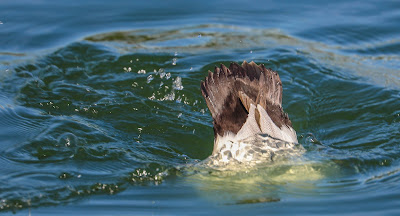 |
| The diving canvasback. |
The canvasback's scientific name, Aythya valisineria, comes from the aquatic wild celery, Valissneria americana, its favorite food during the winter, its non-breeding period. It gives the taste of their meat a delicate, celery-like flavor. It became one of the most popular game birds, sometimes referred to as "King Can" and nearly led to its extinction in the 19th century. Edith Wharton, an American writer and designer, referred to canvasback with black current sauce as a luxurious dinner served in New York City in the 1870s. The Migratory Bird Treaty Act of 1918, which outlawed commercial market hunting, and the creation of national wildlife refuges which helped conserve their wetland habitat, saved them.
Males (drakes) have a rusty head and neck (more brown when non-breeding); a bright red eye in spring and duller red in winter; a black bill, breast and rump; a grayish back; a blackish brown tail; bluish gray legs and feet; and white sides, back and belly with vermiculation resembling the weave of canvas, which gave it its common name.
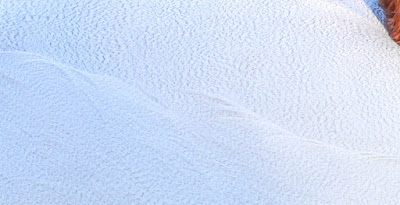 |
| A close-up of the (canvas) back. |
The female has a light brown head and neck, grading into a darker brown chest and fore-back; a black bill; grayish brown sides, flanks and back; and bluish/gray legs and feet.
Many canvasbacks breed in the Prairie Pothole Region, an area covering portions of three Canadian provinces (Alberta, Saskatchewan and Manitoba) and five American states (Montana, North Dakota, South Dakota, Minnesota and Iowa). The so-called "potholes" are shallow wetlands that fill with water in the spring. Those canvasbacks largely migrate south along the Mississippi Flyway to wintering grounds in the mid-Atlantic states and lower Mississippi valley. Some canvasbacks breed in Alaska, Yukon Territory and the Northwest Territories and many of them migrate along the Pacific Flyway to winter along the California coast.
One article says that the "can" is held in almost "religious esteem" by duck hunters, particularly the drake. They are the fastest North American waterfowl, flying at speeds up to 70 miles per hour, which can make them difficult to shoot. As previously mentioned, they are known for the good taste of their meat, and they are relatively rare, one of the least common of the North American duck species, and not widely encountered. Their habitat requirements, both nesting and wintering, are so narrow, that it limits their numbers in the best of times. They nest on the water, winter in open water, and have a limited range of aquatic plants they will feed on.
Information for this post came from the Kern Audubon Society; a wonderful article titled "Large and fast, Canvasback ducks are in a class by themselves" by Shannon Tompkins of the Houston Chronicle on November 29, 2007 and found in a more recent posting of Chron; Wikipedia; and All About Birds.




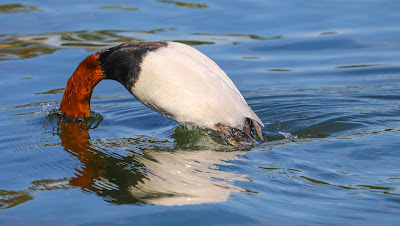


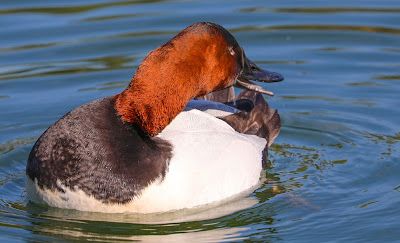



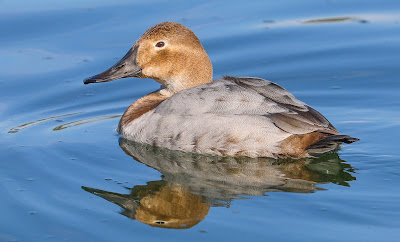








Interesting blocks of solid colors without the feather definition I'm used to seeing in your duck photos.
ReplyDelete